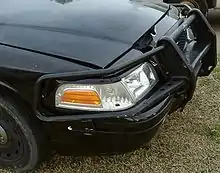PIT maneuver
The PIT maneuver (pursuit intervention technique) or TVI (tactical vehicle intervention) is a pursuit tactic by which a pursuing car can force a fleeing car to turn sideways abruptly, causing the driver to lose control and stop. Other names include pit block, pit stop, and blocking.[1] It was invented by Senior Special Agent Eric James Morris of Tifton, Ga. on May 31, 1992, while he was a cadet at the FBI Academy in Quantico, VA. The first one was performed at 55mph. It was named by a group of FBI cadets and developed by the Fairfax County Police Department of Virginia, United States.[1] Other interpretations of the acronym "PIT" include pursuit immobilization technique, precision immobilization technique,[2] push it tough, parallel immobilization technique, and precision intervention tactic. The technique is also known as tactical car intervention, tactical ramming, legal intervention, and fishtailing.

The technique is used by law enforcement officers to bring car chases to a conclusion.
Other methods of stopping a fugitive vehicle include the use of spike strips, or the use of tactical pursuit and containment (see below).
History

The PIT maneuver was adapted from the bump and run technique used in stock car racing, where a driver would bump a competitor in the rear bumper to cause the other car to lose traction and swerve away from the racing line. The PIT maneuver differs from the bump and run in that the car is bumped from the side near the rear wheel, causing the vehicle in front to spin out. It is illegal to perform this maneuver intentionally in stock car racing because it is very dangerous (although Rusty Wallace used this technique to spin out Darrell Waltrip and win the 1989 All-Star race). The high speed involved in auto racing makes it much easier for drivers to take out another car with a less substantial bump than at lower speeds. When employing the PIT maneuver, the speed of the two cars involved will determine how far the car will travel once it is bumped. Partially for this reason, the higher the speed, the more unpredictable and dangerous the PIT maneuver becomes. This is just one of the very important factors a police officer must consider before implementing the PIT maneuver. A police officer is trained to wait until conditions are right before attempting a PIT maneuver to avoid the use of deadly force. Speeds must be lower and the "landing site" for the bumped vehicle must be clear of danger.
The first US law enforcement agency to teach PIT as a technique to halt fleeing vehicles was the Fairfax County Police Department in Virginia,[3] which modified the parameters for initiating and executing the technique for police use. Terry Pearson and Joseph McDowell were the first law enforcement officers to incorporate the technique into training. Terry Pearson named it the "Precision Immobilization Technique" or P.I.T.
A publication of the United States National Institute of Justice wrote in 1996:
Known initially as "tactical ramming" or "legal intervention", this maneuver was more fully developed and popularized more than a decade ago by BSR Inc., the Summit Point, West Virginia, advanced driver training center, as tactical vehicle interception (TVI), a formal training technique for law enforcement. The first large law enforcement agency to teach TVI as a technique to halt fleeing vehicles was the Fairfax County (Virginia) Police Department, which modified the program for police use and named it "Precision Immobilization Technique" or P.I.T.[1]
Police departments throughout the United States including the San Bernardino County Sheriff's Department in California have come to believe that, when executed properly, PIT is an intermediate force option that can safely end a pursuit. Police vehicles often have reinforced front bumpers to support this technique.
Procedure
The PIT begins when the pursuing vehicle pulls alongside the fleeing vehicle so that the portion of the pursuer's vehicle forward of the front wheels is aligned with the portion of the target vehicle behind the back wheels. The pursuer gently makes contact with the target's side, then steers sharply into the target. The pursuer must also accelerate or its bumper will slide off of the target vehicle.[4] As soon as the fleeing vehicle's rear tires lose traction and start to skid, the pursuer continues to turn in the same direction until clear of the target. This is more of a committed lane change than an actual turn. The target will turn in the opposite direction, in front of the pursuer, and will spin out. The PIT may be done from either side, but consideration must be given to where both cars will end up. Typically, another police car will tail the PIT unit to proceed with the arrest, while the PIT unit recovers its own control and completely stops the car. The PIT does not immobilize the suspect vehicle and to prevent further flight, two police cars need to pin the suspect between them, front and rear.
Avoidance maneuvers
While steering into the skid (away from the pursuing vehicle) will reduce its effect, the fact that the pursuing car is continuing to push the rear of the target sideways virtually ensures loss of control of the targeted vehicle. By moving forward out of position, or by staying squarely in front of the PIT unit, the lead vehicle can disallow the PIT unit from gaining proper positioning to conduct the maneuver. Alternatively, rapid deceleration will, of course, force the PIT unit to overshoot the required positioning.
Advanced defensive driving courses taught to VIP protection units would train drivers in other advanced vehicle control techniques, such as using J-turns as a way of controlling the spin-out resulting from a successful PIT maneuver.
Limitations
The PIT is not applicable in every situation, and many factors affect the usefulness of the technique. Many of these factors relate to safety concerns: typical police regulation recommends that an officer not attempt the PIT at speeds greater than 35 miles per hour (55 kilometers per hour), and requires careful choice of location, considering all possible effects on other traffic vehicles and pedestrians. Because of the police department's potential liability for the injury or death of not only of the occupants of the target vehicle, but also bystanders, most departments limit its use to only the most high-risk scenarios. Most departments specify that the PIT should only be used to stop pursuits that are immediately dangerous and ongoing. When possible, a minimum of three pursuers should be present when a PIT is executed: one as the PIT vehicle and two following at a greater distance to react to the results.
The PIT is especially hazardous when the vehicles' bumpers are of significantly different heights, or against target vehicles with a high center of gravity such as vans or SUVs. High center of gravity vehicles frequently roll over. It cannot be safely used on motorcycles at any speed.
At speeds below 35 MPH, it can be used on a fleeing vehicle, if the legal parameters would justify "less than lethal force" against the driver. At speeds greater than 35 MPH, the technique still works, but it is considered potentially lethal and normally would only be used if lethal force is justified against all occupants. It is best used when the driver is on surface streets and cornering. A high speed motorist may kill innocent people and it can sometimes be justified for that traffic offense. Since there may be unwilling or innocent passengers in the car, there is an inherent difficulty in justifying the use of PITs.
Some suggest that due to the utilization of electronic control systems on modern vehicles, the policies of using PIT maneuvers might need some more consideration.[5]
TPAC
Tactical Pursuit And Containment (TPAC) is a term used by police in the United Kingdom, and describes training for managing and terminating police pursuits. TPAC embodies several methods of stopping fleeing vehicles, including rolling roadblocks, use of spike strips, and the "box and stop" containment method. TPAC is most effective on separated carriageways (such as motorways) where the path of the suspect is limited. It is not suited to roads with frequent cross-roads, those with two-way traffic on a single carriageway, or highways where the suspect may escape by means of a U-turn across the median strip.
Once a fleeing driver is contained on a motorway, a rolling block is initiated ahead of the pursuit. When the pursuit reaches the slowed traffic, the suspect can either attempt to pass the traffic or stay behind it. If the suspect chooses to stay behind the traffic, communication between the pursuing vehicles and the blocking vehicle(s) will lead to the block coming to a standstill, and the vehicle is surrounded and occupants detained. If the fleeing driver chooses to pass the traffic, usually on the hard shoulder, the pursuing vehicles follow it. Once past the traffic, the police vehicles can box in the suspect's vehicle and bring it to a controlled stop through coordinated braking, utilizing the sterile area in front of the blocking vehicle(s) to do so without endangering other road users.
In the UK, TPAC is specialist training given to advanced police drivers. As with the PIT technique, consideration has to be given to the size, weight and center of gravity of the fleeing vehicle.
British police are comfortable with the TPAC, as fleeing drivers are usually considered to be unarmed, and driving beside or in front of them is not a hazard. Police in the US assume the driver is armed and prefer the PIT maneuver, as it is done from behind the suspect vehicle.
The typical PIT, seen in North America, can be utilised by trained police officers in the UK, typically on roads policing or armed response units. Rather than being referred to as a PIT, it simply forms part of 'tactical contact'.
References
- Law Enforcement Pursuits in Georgia: Review and Recommendations Archived 2013-10-29 at the Wayback Machine
- Raviv, Shaun, and John Sullivan, "Police driving maneuver used to end chases has killed 30 people since 2016, The Post finds", Washington Post, August 24, 2020. Retrieved 2020-08-24.
- Eric J. S. Townsend, "Police End Car Chases with a Spin", News and Record, 2004
- Mascarenas, David; G. Park; C. Farrar (2011-11-27). "Escape and Evade Policies for High-Speed, Autonomous Unmanned Ground Vehicles" (pdf). Los Alamos National Security.
- Zhou et al.Jing Zhou, Jianbo Lu, and Huei Peng, "Vehicle Dynamics In Response to The Maneuver of Precision Immobilization Technique," Proceedings of ASME Dynamic Systems and Control Conference, 2008 provides a study for vehicles equipped with Electronic Stability Controls (ESC) in response to PIT maneuvers.